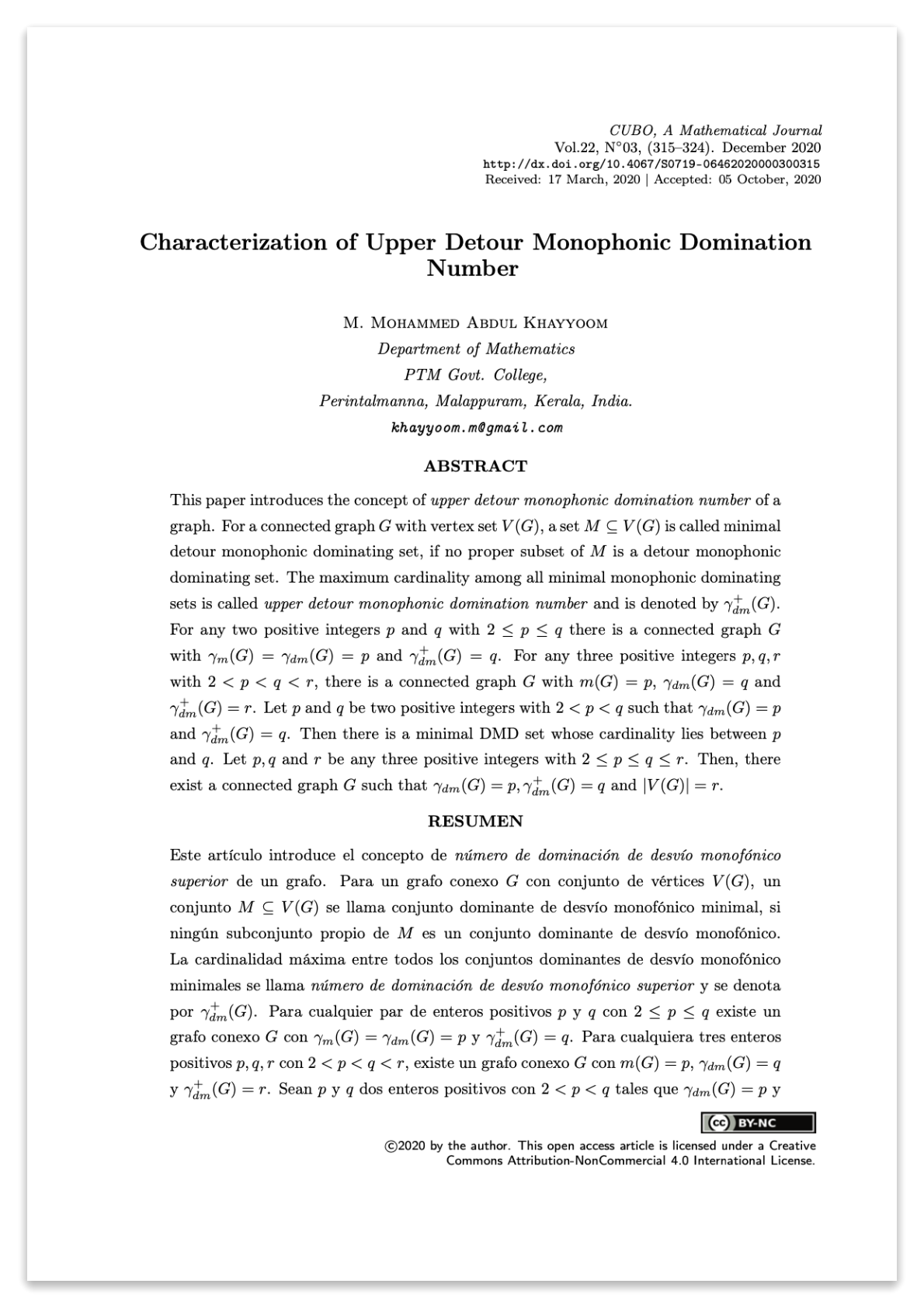Characterization of Upper Detour Monophonic Domination Number
-
M. Mohammed Abdul Khayyoom
 khayyoom.m@gmail.com
khayyoom.m@gmail.com
Downloads
DOI:
https://doi.org/10.4067/S0719-06462020000300315Abstract
This paper introduces the concept of upper detour monophonic domination number of a graph. For a connected graph \( G \) with vertex set \( V(G) \), a set \( M\subseteq V(G) \) is called minimal detour monophonic dominating set, if no proper subset of \( M \) is a detour monophonic dominating set. The maximum cardinality among all minimal monophonic dominating sets is called upper detour monophonic domination number and is denoted by \( \gamma_{dm}^+(G) \). For any two positive integers \( p \) and \( q \) with \( 2 \leq p \leq q \) there is a connected graph \( G \) with \( \gamma_m (G) = \gamma_{dm}(G) = p \) and \( \gamma_{dm}^+(G)=q \). For any three positive integers \( p, q, r \) with \(2 < p < q < r\), there is a connected graph \( G \) with \( m(G) = p \), \( \gamma_{dm}(G) = q \) and \( \gamma_{dm}^+(G)= r \). Let \( p \) and \( q \) be two positive integers with \( 2 < p<q \) such that \( \gamma_{dm}(G) = p \) and \( \gamma_{dm}^+(G)= q \). Then there is a minimal DMD set whose cardinality lies between \( p \) and \( q \). Let \( p , q \) and \( r \) be any three positive integers with \( 2 \leq p \leq q \leq r\). Then, there exist a connected graph \( G \) such that \( \gamma_{dm}(G) = p , \gamma_{dm}^+(G)= q \) and \( \lvert V(G) \rvert = r\).
Keywords
P. A. P. Sudhahar, M. M. A. Khayyoom and A. Sadiquali, “Edge Monophonic Domination Number of Graphs”. J. Adv.in Mathematics, vol. 11, no. 10, pp. 5781–5785, 2016.
P. A. P. Sudhahar, M. M. A. Khayyoom and A. Sadiquali, “The Connected Edge Monophonic Domination Number of Graphs”. Int. J Comp.Applications, vol. 145, no. 12, pp. 18–21, 2016.
G. Chartrand and P. Zhang, Introduction to Graph Theory. MacGraw Hill, 2005.
T. W. Haynes, S. T. Hedetniemi and P. J. Slater, Fundementals of Domination in Graphs. 208, Marcel Dekker Inc, New York, 1998.
J. Jhon and P. A. P. Sudhahar, “On The Edge Monophonic Number of a Graph Filomat”, vol. 26, no. 6, pp. 1081–1089, 2012.
J. Jhon and P.Arul Paul Sudhahar, “The Monophonic Domination Number of a Graph, Proceedings of the International Conference on Mathematics and Business Managment”, pp. 142–145, 2012.
M. M. A. Khayyoom and P. A. P. Sudhahar. “Edge Detour Monophonic Domination Number of a Graph. International Journal of Pure and Applied Mathematics”, vol. 120, no. 7, pp. 195–203, 2018.
M. M. A. Khayyoom and P. A. P. Sudhahar, “Connected Detour Monophonic Domination Number of a Graph”. Global Journal of Pure and Applied Mathematics, vol. 13, no. 5, pp. 241–249, 2017.
S. R. Chellathurai, and S. Padma Vijaya, “Upper Geodetic Domination Number of a Graph” Int. Journal of Cont. Math Sci., vol. 10, no. 1, pp. 23–36, 2015.
P. Titus, A. P. Santhakumaran, K. Ganesamoorthy, “Upper Detour Monophonic Number of a Graph”, Electronic Note in Discrete Mathematics, vol. 53, pp. 331–342, 2016.














